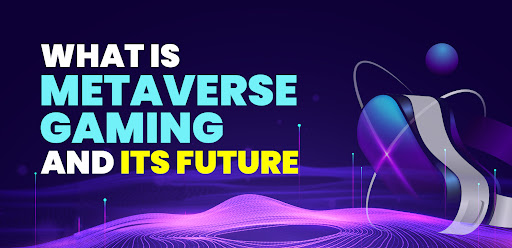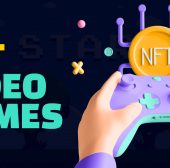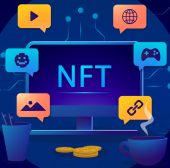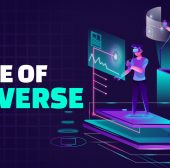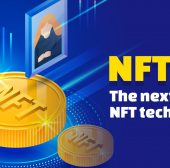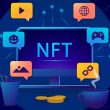Imagine the internet, which we use daily to play games with our pals or make online purchases. The entire internet experience that we currently have is basically 2D. At the same time, some of the applications which we often use have 3D components. The concept of Metaverse gaming improves the whole internet experience to a 3D world where the users can interact with each other through their avatars and the virtual world around them using modern HCI (human-computer interaction) software and hardware.
The Metaverse is not a newly created word, and it was originated in 1992. Author Neal Stephenson invented the term first time in his fiction novel “Snow Crash”, imagining avatars who can meet and talk in a digital space. It is a combination of various technologies such as virtual reality, machine learning, augmented reality, artificial intelligence, and blockchain technology. Players can use this technology to develop a virtual identity and enter the digital world. They can have a captivating experience by adapting to their surroundings rather than focusing on a flat-screen. Metaverse gaming gives an illusion of you being part of the virtual world in real life.
NFTs, on the other hand, are a new class of digital assets that is one-of-a-kind, valuable, immutable, and indivisible. They show the ownership of virtual assets like weapons, costumes, avatars, and many more. Nob-fungible tokens are safely stored on a blockchain technology behind cryptocurrencies. The NFTs technology plays a vital role in Metaverse game development. Once you buy a specific virtual object, you own a token that is certified on a blockchain and establish your connection with the virtual asset.
Metaverse and Gaming - The two sides of the same coin
In the gaming sector, the Metaverse is not a newly invented term. It is one of the major sectors which allows users to interact in ways they have never done before in a challenging game environment. It enables players to create, sell and trade objects in NFTs form in a shared digital realm. NFT gaming technologies are breaking the digital world’s limits, allowing gamers not only to trade items but also they can even transfer them through the Metaverse.
This word is used by a few gamers in their gaming experience. With the right equipment VR headset, players will get an opportunity to teleport to their favourite games in person quickly. The online free-to-play cross-platform battle royale game Fortnite is the finest example of proto-metaverse. The gaming industry has evolved to the advanced world of virtual avatars and transactions that are powered by cryptocurrency or NFT (Non-Fungible Tokens).
Top 7 advantages of NFT in gaming
NFT in gaming will be one of the most important new developments in 2022, and it will be challenging for developers as well as publishers to ignore it. As it is a virtual environment, Metaverses have a wide range of features. However, the following are the most essential:
Gamers will have more control
When playing traditional games, players are acquainted with buying in-game items through seasons passes and microtransactions. But, NFT in gaming gives an opportunity to players to sell the in-game items and earn a share of future resales. Thus, giving players to have full control over their earned and acquired assets. This gives a great chance to players to invest in virtual assets. It is an excellent opportunity for gamers in the digital age, mainly those who grew up trading old games to fund new ones. For instance, in the Fortnite game, a player can change the character’s skin. This game creates a scarcity, but it is in the control of the developer. NFT in gaming allows players to control the sale and resale of items.
Rise of Play-to-Earn games
NFTs are advancing due to the popularity of play-to-earn model games, and some players are even making a living from them. Despite the fact that numerous Play-to-Earn games, like Pokemon, are identical to non-NFT games, there are claims that some of them are backdoor blockchains. Under the pretext of collectable objects, the game comes second to trade and buying cryptocurrency. Furthermore, by playing the games and winning them, users will win rewards in cryptocurrency form. Remember, Play-to-Earn games can also be challenging to navigate crypto wallets, buy-in fees, hidden costs, and more. However, by combining the best ideas and UX design of Free-to-Play and Play-to-Earn, there is still an opportunity for improvement.
NFT in gaming adds value
Till now, any objects that a user invest or unlocks in a game have a value within the game. Also, that money is lost if the game shuts down. On the other hand, NFT in gaming unlocks and adds value to gameplay that is already experienced. It is vital because NFTs have the potential to make a second-hand market for virtual games and objects effectively. NFT gaming lets users be the legal owners of in-game things, which they can sell, trade, or hold. This is possible by blockchain technology and an NFT-based in-game economy. Users making money from a game isn’t a new concept, but NFTs are safer and adaptable.
Interoperability
As stated earlier that NFT is based on blockchain. This provides the present system with a high level of security and interoperability. This is one of the most appealing features of NFT games. Classic console and PC games each have an environment that is incompatible. The assets and characters of the players are always restricted to that specific game. Games that are based on blockchain technology, on the other hand, boast interoperability - the ability to use specific game objects in various locations. NFT games can coexist on the interoperable or identical blockchain, with game assets that can be traded with other gamers.
Authenticity
NFT perks are mostly dependent on their uniqueness. As non-fungible tokens are produced on the blockchain, they are linked to specific records. The NFTs unique feature exhibits their potential for contributing value. Similarly, the makers of NFT have the possibility to issue a particular number of NFTs in order to build scarcity of supply. With play-to-earn gaming models that are by nature publicly decentralized, run virtual assets on blockchain portals. This makes NFTs immutable, which offers the assurance of authenticity. Immutability ensures that blockchain-based NFTs remain unaffected by changes, replacement, or removal. As a result, NFTs might simply represent their authenticity as the most valuable quality.
NFT games will lead the metaverse
The NFT powered games are far ahead of the curve for those looking at the perks of blockchains and metaverse. Games will be a part of the Metaverse, and Non-fungible tokens will connect them to their aspects of the connected, virtual future. The Metaverse will be distributed across the internet presented on various portals, games, and websites. This alters the way we play games, interact, and socialize. Gaming companies are competing to enter the Metaverse games. Metaverse and NFT gaming have already begun, and it will make it swiftly and easier.
Next-generation social experiences
Metaverse is to reinvent existing social interactions, and NFTs play a critical part. By owning specific NFT avatars, in-game assets, and items, players can authenticate their identity among the different avatars accessible in the digital universe that can be traded, bought or sold. This further provides users exclusive membership experiences in both the Metaverse as well as the real world. Therefore, the social experiences are enhanced.
Future of Metaverse and NFT in gaming
Metaverse is still in its early stages, and innumerable gaming companies are working on developing it. It is a vast concept, and NFTs can play an important role in the wide ecosystem. Although Metaverse and NFT are two different entities, the design is the common thread that binds them both. In both Metaverse and NFT, a game designer's involvement is unavoidable. In order to create experiences that are a gateway into another universe, game designers will need to shift their skills, perspective, and approach. To create fantastic experiences for players, they must develop a fully engaging design. Developing the digital worlds that allow them to live in them rather than just experience it.
Even though game app developers are still a long way from it, the indications of the Metaverse are becoming more evident. With the rapid rise of Metaverse and NFTs, game designers will undoubtedly play a significant role in the future. While some companies are still figuring out what the term means, the Metaverse is leading in the gaming industry. For instance, games like Fortnite, where players can dress up as their preferred Marvel or Star Wars characters, and in gaming portals like Roblox where you can gather badges and built your own world online. Same as the internet, Metaverse gaming will be the next big thing.
Conclusion
In the gaming world, Metaverse refers to a concept that allows players to visualize different worlds. It will be a truly innovative and drastic method to enhance your digital experiences. It has the ability to revolutionize the way individuals interact with technology and people. Within seconds you will be able to make your human-like avatar, create a virtual room and enjoy a digital presence that is more like real-world interactions. As a result, a growing number of companies are searching for ways to adopt it. Considering the pace at which technologies are developing and companies are generating unique ideas surrounding immersive reality, it is a matter of time before the Metaverse becomes a reality. Moreover, NFTs also become more advantageous in terms of adding value and sustainability to the gamer's revenue by making them openly available on numerous interoperable blockchain portals. As a result, one will reasonably expect the best Metaverse and NFT games to make headlines in the coming years. How do you feel about the information that we shared in this article? If there is any suggestion or feedback about Metaverse and NFT future, you can contact us or drop us an email at enquiry@logicsimplified.com
 Get a Quote
Get a Quote

